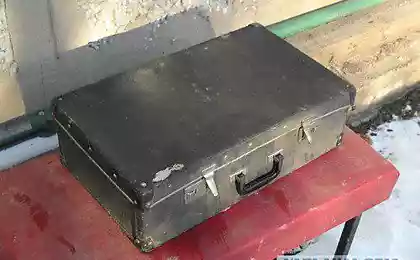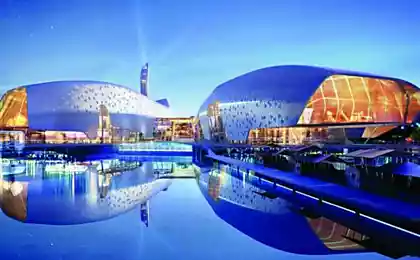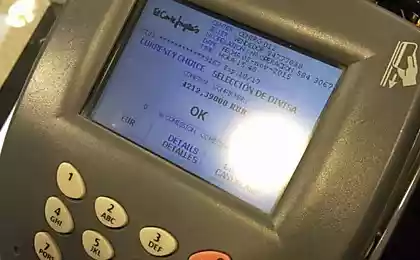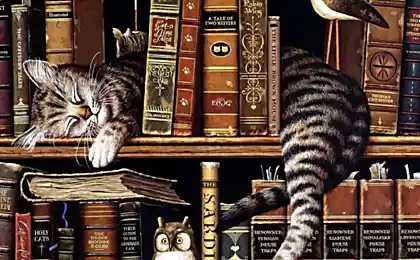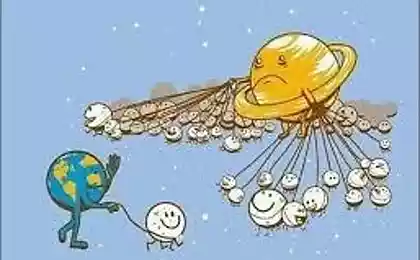974
The terminal, where nobody is flying
For a long time there is no American Airlines Trans World Airlines (TWA), once one of the largest in the US, and the same one that was once owned by eccentric millionaire Howard Hughes. But to visit the passenger terminal TWA, built in the 60's, you can still.
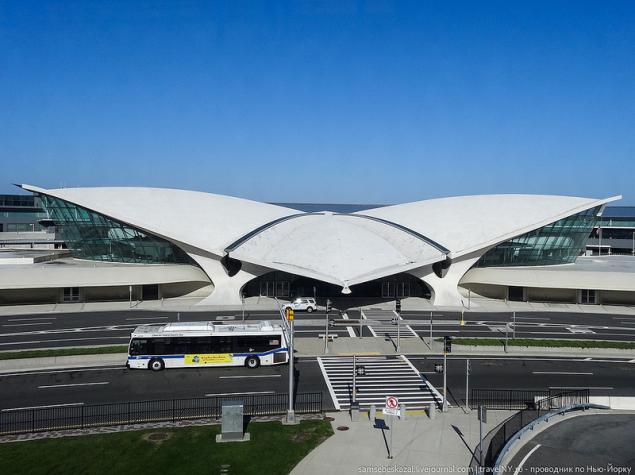
In New York, there are places where time seems to have stopped a long time ago, and it seems that nothing can not change this state of affairs. Here, for example, no longer exists airline called Trans World Airlines (TWA), once one of the largest in the US, and the same one that was once owned by eccentric millionaire Howard Hughes. But so far, with more luck, you can find yourself in the passenger terminal TWA, built in the 60s and hardly changed since then, when the small but fast aluminum bird finally sent plowing the ocean giants in the dustbin of history and irrevocably changed all our lives . To touch this timeless story of missed have to go to the airport John F. Kennedy, into a single terminal, where nobody is flying.
In the center, between the terminal 5 and the multi-level parking, it is located an unusual building that looks very similar to the spaceport of the films 60, which shows the near future, something about the beginning of the 21 th century, when ideas filmmakers people had to fly on cars with large glass caps and live on other planets. But unlike the movie is not an invention of the writer and not the scenery, but a real passenger terminal called «Trans World Flight Center», built in 1962, designed by American architect Eero Saarinen Finnish origin. It is called the "Grand Central era of jet airliners," and this is probably one of the most unusual in the world of Flyaway. Built more than 50 years ago, he even by today's standards, it looks fantastic.
Trans World Flight Center is a real Expressionism in architecture, or rather its post-war recovery. The entire building is composed entirely of curves, streamlined forms and smooth transitions from one to another. This gives a fairly massive concrete structure a sense of weightlessness and flight. It is as if floating above the ground, and this is no accident.
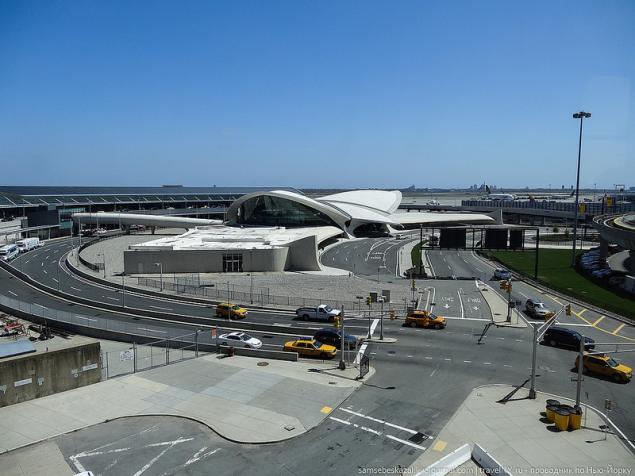
The building symbolizes the flight and is designed as a large white bird with huge wings. This architectural design is clearly visible just a few angles.

4.

Saarinen began work on the project of a new terminal in 1955, when the airport is still called Idlewild. And then, and now, the practice of building a separate terminal for one airline was not very common in the world. But New York's Idlewild International Airport was one of the main airports of the country, its front gate for travelers from around the world, and central home base for several major US airlines. Therefore, terminals have been more than just a place of embarkation and disembarkation of passengers. Then began the era of mass tourism, the number of passengers is constantly growing and needed a completely new concept in the organization of air transport. Just a small terminal building was not enough. Saarinen began to tackle emerging issues yet to passenger transport and the organization of passenger traffic with the help of design and architectural forms. The new concept required more time and he asked to delay for a year for the project. Guide TWA was so passionate about his ideas that no problems had agreed to such a delay. In 1957 he was presented the first draft. For airlines new building became a real symbol and reflection of their new philosophy.

Advertise a new terminal TWA.

The terminal is being built. 1961

After opening in 1962.
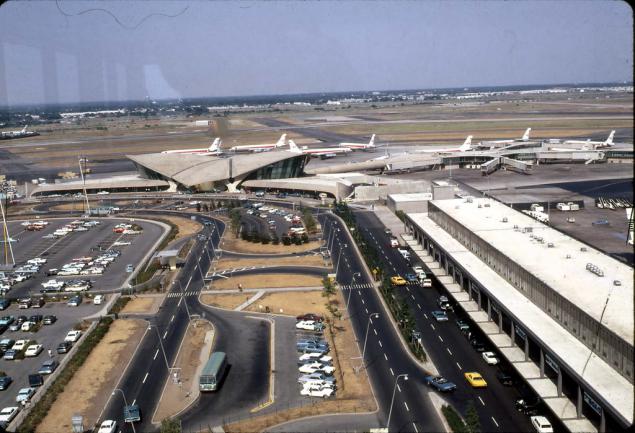
The view from the window of an airplane taking off
Approximately the same point today

10. View the transition to Terminal 5.

Transitions, which led to the hubs, from where the boarding. At first it was a single building, but then, with the advent of the giant aircraft such as the Boeing 747, was attached to another building and was two transitions. It was first applied to the scheme, when the registration and landing were in different buildings connected by passages. Now walkway connects Trans World Flight Center to Terminal 5.

Inside a large hall, reception desk, waiting area, restaurant, toilets and even a shoe shine stand. A huge box waiting room made the room wonderfully bright and direct access to the airfield.

The internal volume of more unusual than the external shape of the building. There are no sharp edges and walls, and everything seems flows from one to the other, symbolizing the constant movement. You get to the terminal and the invisible flow smoothly carries you from the waiting room to the front desk, throws on the island next to the cafe, then to tighten again in a turbulent maelstrom, to carry on transitions and throw directly to the plane. You seem to have already started their journey just entering into the building.
1962.

14.

It's hard to imagine that modern architects have paid much attention even objects such as transitions. Now they are trying to do as much as possible air and unobtrusively, while Saarinen received a simulacrum of the arteries connecting the different parts of the body. Building with some parties in general is quite reminiscent of a living creature or plant from another planet.

Future was not only architectural forms. Trans World Flight Center used the most advanced ideas in the organization of passenger traffic at the time. It was one of the world's first passenger terminal, which started using jetways, announce flight information on the speakerphone, there appeared the first video surveillance system, luggage carousel, electronic scoreboard with a schedule of flights, and electronic scales at the reception.
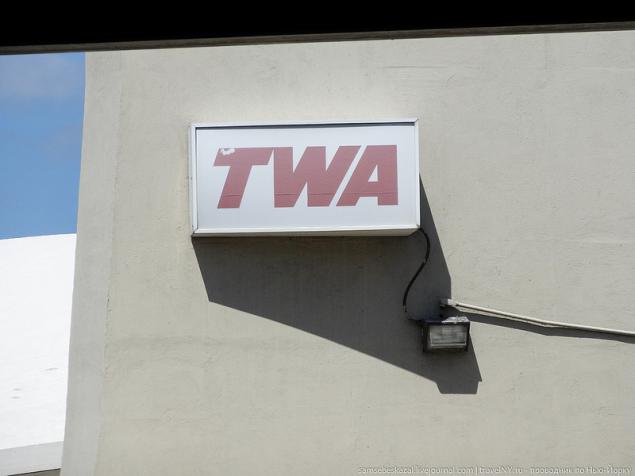
Saarinen himself died in 1961 of brain cancer in the prime of life, and not live just a year before the moment when the first passengers began their journey from the depths of a large concrete bird.
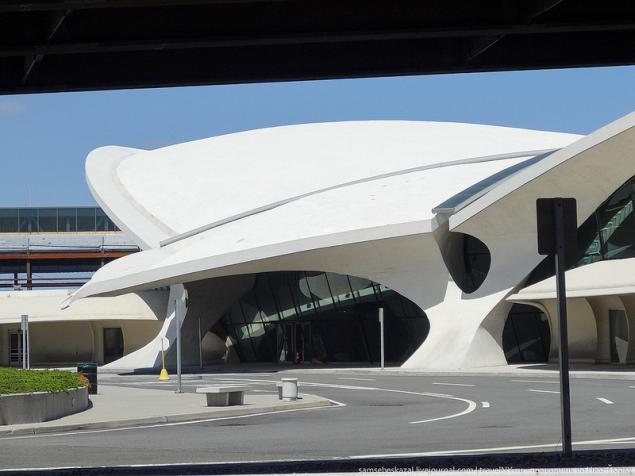
TWA company ceased to exist in 2001. Trans World Flight Center is obsolete, no longer cope with the passenger traffic and to meet modern safety standards. As a result, it was nearly demolished in order to build on this place another faceless box, but fortunately, in time to come to their senses and gave the terminal status of a monument of architecture. Now the demolition does not threaten him, but the future is still uncertain. Most likely to make him a cultural center and museum. Now the terminal is closed and it is impossible to get inside. It only remains to wait for some event, such as New York's open day, or something like that. Consider it from all sides is possible only with a roof where there is a parking station AirTrain, out of the car or train from Terminal 5 to come closer, unfortunately, will not work.
18. That is now the future of the past.

Interior photos of the author links

20
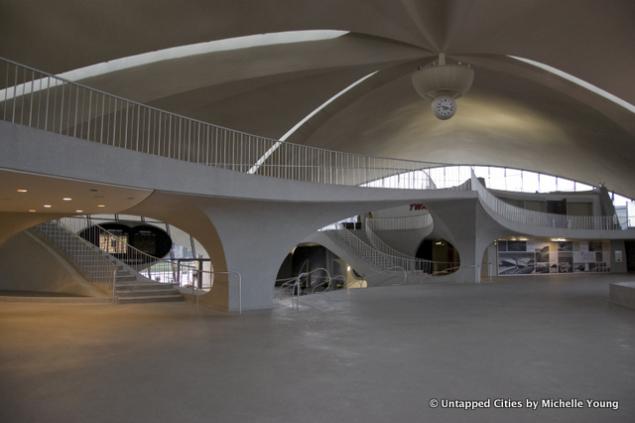
21

22

23

24

25

26. Images from the well-known movie "Catch Me If You Can»

27
source
Everything.
Here you can see more photos

Source:

In New York, there are places where time seems to have stopped a long time ago, and it seems that nothing can not change this state of affairs. Here, for example, no longer exists airline called Trans World Airlines (TWA), once one of the largest in the US, and the same one that was once owned by eccentric millionaire Howard Hughes. But so far, with more luck, you can find yourself in the passenger terminal TWA, built in the 60s and hardly changed since then, when the small but fast aluminum bird finally sent plowing the ocean giants in the dustbin of history and irrevocably changed all our lives . To touch this timeless story of missed have to go to the airport John F. Kennedy, into a single terminal, where nobody is flying.
In the center, between the terminal 5 and the multi-level parking, it is located an unusual building that looks very similar to the spaceport of the films 60, which shows the near future, something about the beginning of the 21 th century, when ideas filmmakers people had to fly on cars with large glass caps and live on other planets. But unlike the movie is not an invention of the writer and not the scenery, but a real passenger terminal called «Trans World Flight Center», built in 1962, designed by American architect Eero Saarinen Finnish origin. It is called the "Grand Central era of jet airliners," and this is probably one of the most unusual in the world of Flyaway. Built more than 50 years ago, he even by today's standards, it looks fantastic.
Trans World Flight Center is a real Expressionism in architecture, or rather its post-war recovery. The entire building is composed entirely of curves, streamlined forms and smooth transitions from one to another. This gives a fairly massive concrete structure a sense of weightlessness and flight. It is as if floating above the ground, and this is no accident.

The building symbolizes the flight and is designed as a large white bird with huge wings. This architectural design is clearly visible just a few angles.

4.

Saarinen began work on the project of a new terminal in 1955, when the airport is still called Idlewild. And then, and now, the practice of building a separate terminal for one airline was not very common in the world. But New York's Idlewild International Airport was one of the main airports of the country, its front gate for travelers from around the world, and central home base for several major US airlines. Therefore, terminals have been more than just a place of embarkation and disembarkation of passengers. Then began the era of mass tourism, the number of passengers is constantly growing and needed a completely new concept in the organization of air transport. Just a small terminal building was not enough. Saarinen began to tackle emerging issues yet to passenger transport and the organization of passenger traffic with the help of design and architectural forms. The new concept required more time and he asked to delay for a year for the project. Guide TWA was so passionate about his ideas that no problems had agreed to such a delay. In 1957 he was presented the first draft. For airlines new building became a real symbol and reflection of their new philosophy.

Advertise a new terminal TWA.

The terminal is being built. 1961

After opening in 1962.

The view from the window of an airplane taking off
Approximately the same point today

10. View the transition to Terminal 5.

Transitions, which led to the hubs, from where the boarding. At first it was a single building, but then, with the advent of the giant aircraft such as the Boeing 747, was attached to another building and was two transitions. It was first applied to the scheme, when the registration and landing were in different buildings connected by passages. Now walkway connects Trans World Flight Center to Terminal 5.

Inside a large hall, reception desk, waiting area, restaurant, toilets and even a shoe shine stand. A huge box waiting room made the room wonderfully bright and direct access to the airfield.

The internal volume of more unusual than the external shape of the building. There are no sharp edges and walls, and everything seems flows from one to the other, symbolizing the constant movement. You get to the terminal and the invisible flow smoothly carries you from the waiting room to the front desk, throws on the island next to the cafe, then to tighten again in a turbulent maelstrom, to carry on transitions and throw directly to the plane. You seem to have already started their journey just entering into the building.
1962.

14.

It's hard to imagine that modern architects have paid much attention even objects such as transitions. Now they are trying to do as much as possible air and unobtrusively, while Saarinen received a simulacrum of the arteries connecting the different parts of the body. Building with some parties in general is quite reminiscent of a living creature or plant from another planet.

Future was not only architectural forms. Trans World Flight Center used the most advanced ideas in the organization of passenger traffic at the time. It was one of the world's first passenger terminal, which started using jetways, announce flight information on the speakerphone, there appeared the first video surveillance system, luggage carousel, electronic scoreboard with a schedule of flights, and electronic scales at the reception.

Saarinen himself died in 1961 of brain cancer in the prime of life, and not live just a year before the moment when the first passengers began their journey from the depths of a large concrete bird.

TWA company ceased to exist in 2001. Trans World Flight Center is obsolete, no longer cope with the passenger traffic and to meet modern safety standards. As a result, it was nearly demolished in order to build on this place another faceless box, but fortunately, in time to come to their senses and gave the terminal status of a monument of architecture. Now the demolition does not threaten him, but the future is still uncertain. Most likely to make him a cultural center and museum. Now the terminal is closed and it is impossible to get inside. It only remains to wait for some event, such as New York's open day, or something like that. Consider it from all sides is possible only with a roof where there is a parking station AirTrain, out of the car or train from Terminal 5 to come closer, unfortunately, will not work.
18. That is now the future of the past.

Interior photos of the author links

20

21

22

23

24

25

26. Images from the well-known movie "Catch Me If You Can»

27
source
Everything.
Here you can see more photos

Source:




